Now here is a uke that put a smile on my face! I have been lucky enough to grab a Kiwaya KS-5 soprano ukulele and have been putting it through its paces.
Kiwaya are a Japanese brand of ukulele with a relatively small range, with a focus on attention to detail and very high quality. Their range is split between solid wood ukes, and laminates - and the KS5 is an all laminate ukulele. It also costs just over £200. It was sourced for me by the fine folks at The Southern Ukulele Store in the UK.
Woahh!!!!! Hang on there Baz..... how much for a laminate? And I thought laminates meant 'cheap'....
Well, yes, it's a serious price, but then as you read on you will see it is a serious instrument. And as for it being laminate - well, there is laminate and there is 'laminate'! The use of laminated woods in quality musical instruments is not actually that unusual, it is just that we have become used to laminate meaning 'cheap' because the market has been flooded with so many bargain ukuleles like Mahalos. Laminate on those entry level cheapies is nothing more than plywood, and very thick plywood at that. Those sort of laminates sap tone and volume and make the instrument heavy. In the guitar world however, many top end makers and private luthiers have been working with professional quality laminates for some years (including Taylor and Martin). Not only is it cheaper, but it is stronger and capable of being made thinner and bent into shape easier than solid wood. And let's dispel another myth, that laminate sounds 'worse' than solid wood. Not necessarily, and a high end laminate can easily beat a cheap solid wood uke every time... Sure, it won't age and change in tone like solid wood can, but a pro laminate can make a fine instrument. So it's funny really. Some people get really sniffy about laminates and think only a solid would uke actually counts as an instrument. Sure, with entry level cheap laminates, many can be pretty horrid but that doesn't mean all laminate is bad.
And that is what Kiwaya chose to do with the KS5, part of their 'Eco Series' (as a tree wasn't felled to make it....). It is made from a high grade professional quality laminate. In this model the finish is a Koa veneer and in Japan it is known as the FS-5. I note they also do a cheaper mahogany veneer laminate too. And that high quality laminate is abundantly obvious when you pick the ukulele up for the first time. This instrument is incredibly light and when you look at the edge of the sound hole, the laminate is also extremely thin - something much more easily achieved with laminate than solid wood. It really is as light as a feather, and that thin wood is designed to help with volume, tone and sustain. In fact I suspect a solid would uke built this thinly would be far too easy to break or split. As such, Kiwaya have worked cleverly with the material. Knowing that laminate is strong, they have used that to create a lightweight instrument. In general terms a lighter thinner body will help resonance.
So looking at the body - the Koa veneer is really rather pretty, if a little on the light end of the scale for my liking (I do prefer darker wood) - but it really is a good looker! The KS5 is styled in the typical Martin fashion (as are many Kiwayas which some people consider to be as close to the vintage Martins as you can get.). So we have a traditional shape double bout ukulele. The grain of the wood is straight and the top and back are a single piece. At this price point there is little curl or wave in the Koa finish, but there is enough stripe and shimmer in the colouring to make this look pleasing. Nice also to see a bit of arch to the back which aids with sound projection (a feature I am seeing more and more with ukuleles).
The bridge follows the traditional Martin design in that it is made of hardwood and is a slot type making string changes a breeze - just tie a knot and slot it in! The saddle appears to be plastic and is one of the most extreme looking compensated saddles I have ever seen - it looks like a wave! The jury is still out with me as to whether a compensated saddle means anything on a uke, but from what I have been told about Kiwayas, their attention to detail is millimetre accurate and this compensated saddle actually works in pinning that tuning down perfectly. Fair enough.
There is little other bling on the uke, and the soundhole has a transfer type rosette in a simple design. Thankfully being under gloss it shouldn't wear off. The sides are a single piece and the back is very slightly arched to help with projection. The body is finished in gloss which is not normally my thing, but seems to suit the instrument. A word about the finish though - I have seen better gloss on ukuleles - this seems to be a little heavily applied as shown around the end of the fretboard and around the bridge. It's also not polished to a high mirror like shine and looks a little bumpy or what they call 'orange peel' in the finish. I suppose it looks vintage in the finish (probably what was intended, in keeping with the Martin styling) but I have seen better. That isn't to say the gloss is too thick, it's just not perfect. Perhaps a minor gripe.
Inside the uke looks very tidy, with the back and top connected to the sides with simple un-notched kerfling. There are no glue drops or seepage signs, and the Kiwaya label complete with hand written serial number is small and dainty.
On to the neck. Its a hardwood neck in three pieces. There is no joint at the headstock, but the heel of the neck is stacked in three pieces - something that is expected at the price point I suppose. I always mention neck construction in my reviews and it is perhaps worth pointing out that I am not convinced there are any benefits attached to a single piece neck over a jointed one. Some claim extra sustain, but I am not sure I buy that. With many jointed necks though, you can see the joins, so for me it is just a case of aesthetics.
The fingerboard is rosewood and is superbly finished. It is unbound (meaning fret edges are visible) but the edges of the fingerboard are 'rolled' meaning no sharp feeling and supreme comfort in the hand. A nice touch.There are 15 nickel frets (12 to the body) and they are perfectly finished with no rough edges at all. Fret markers are in mother of pearl at the 5th, 7th and 10th and it is pleasing to see side markers too. Nut width seems a little wider than standard, or perhaps that is just me (it measures 37mm or 1.5 inches across - but either way it feels very comfortable and spacious). The neck really is one of the high points of this uke.
The headstock is in traditional Martin style with a three pointed crown finish. The face of the headstock is finished in Koa veneer and the Kiwaya logo is a transfer under the gloss in a nice subtle gold finish. I really like the logo as it looks vintage and classy, and is in keeping with the rest of the instrument.
Tuning is provided by Gotoh friction pegs, with white buttons and gold posts. They look superb and are totally in keeping with the look of the ukulele ( I do like to see friction pegs on a soprano uke). They work just fine and have held tuning perfectly since it arrived. And remember - don't be afraid of friction tuners!
Other than that, the uke comes with a beginners chord booklet, and from the look of the pink colour of the strings it arrived with, they looked like D'Addario Titaniums (there seems to be some variation in strings these arrive with, and some apparently come with Hilo strings). No matter - I always experiment with strings on each new ukulele, as I have done with this one and it is now strung with Living Water strings which suit it nicely I think.
So overall it really is a rather nice looking instrument. Despite the gloss finish, the uke is built very, very well and is light as a feather. It's a joy to look at and looks like something that has been unearthed, unplayed, in an attic from 60 years ago. Very classy.
How does it play? Well, in a nutshell - beautifully! The weight of the uke makes it very nicely balanced to hold with no strap, and the neck is ever so comfortable to fret. The first thing that strikes you is the volume of the instrument - wow - this packs a punch - helped by that ultra thin laminate and arched back. It really does bark if you want it to, all with very nice clarity. The tone is typically soprano, with a richness to it that you would really only expect on handmade all solid ukes costing many times this price. The sustain and power are so noticeable you can really feel the ukulele resonating against your chest when you play it which is pretty impressive for a laminate model.
The tone chimes and sings, and there is very nice separation between the strings, and harmonics too. Quite honestly, this is one of the nicer sounding soprano ukes I have had the pleasure to play. In fact, (and it pains me to say this) the sound of this is far far closer to the sound of a Koaloha Soprano than I would really like to admit (considering the price difference and the fact I own a Koaloha!). I have played the solid version of the Kiwaya and sure, there is more depth to the sound but honestly, this uke has a great voice. If I had to criticise I suppose it is a little bit more one dimensional than some high end ukes and thinner sounding than the Koaloha, but really, I am looking for issues with it to say that, and really it sounds superb. Put it this way - play one of these in a ukulele group and your tone will stand out, no question.
Setup was also completely trouble free with perfect action at the nut and saddle for my liking, meaning spot on accuracy all over the neck. No issues! Japanese attention to detail I suppose.
So I am extremely happy with this. The uke shows absolute first class attention to detail in the build and tone, and as a laminate..... well - it is better sounding than many, many solid wood ukes I have played so who cares?
First class and highly recommended.
STOP PRESS - as at early 2015, the price of these has gone up significantly and they are now closer to £300 to buy. Interestingly I still would stand by everything in this review - great ukes.
PROS
Sublime looks and build quality
Light as a feather
Wonderful feel on the fingerboard
Tone and volume to die for
CONS
Gloss finish could have been better finished
SCORES
Looks - 9.5
Fit and Finish - 8.5
Sound - 9
Value For Money - 9.5
OVERALL - 9.1
To understand my review scoring and see this result in context - visit my review page at
VIDEO REVIEW

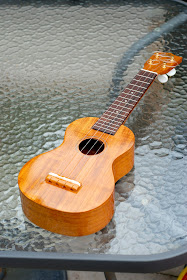

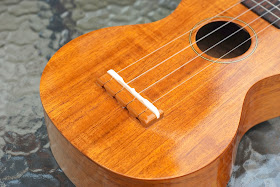
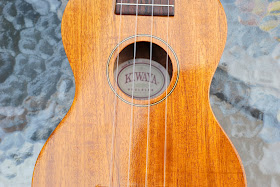
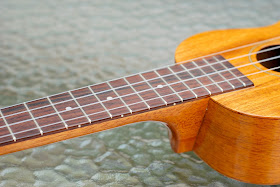
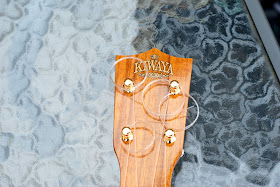
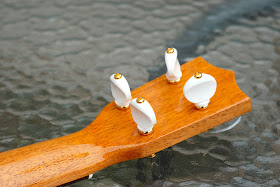
Ahhh, The Kiwaya. What a beautiful ukulele. My main uke is the pineapple version of this one you've reviewed. I picked it up on my last tour of Japan. When purchased in Japan the name on the headstock is 'Famous' and if purchased anywhere else in the world the 'Kiwaya' logo appears. I do agree with everything you've said in all positive aspects. A couple of differences perhaps. My gloss finish is perfect, no 'orange peel' and even though through this model Kiwaya has done a wonderful job of re-making the vintage 'Martin', I'm not a big fan of that bridge. It feels soft, not strong to me and I've already (my stupid fault) chipped a little sliver of the wood off whereby I have to double knot the 'A' string. That was both disappointing and annoying. When in Japan last year I immediately replaced the stock strings with a set of Worth browns, about three months ago installed a set of the Living Waters and decided that for me the sound was a little 'brittle' and switched back to the Worths very recently. I was determined to come home with a beautiful Japanese ukulele and I'm in love with this lifer! Cheers!
ReplyDeleteGreat review. It convinced me to get a KS-5 for myself...until I found out it now costs 300 pounds. Oops!
ReplyDeleteThanks. Kiwaya make superb ukes!
ReplyDeleteI totally agree with your review. I've had the chance to play one and I fell in LOVE with it...and I'm planning on getting one. it's really THAT good!. Mario
ReplyDeleteMartin - definitely better than the Islanders in my opinion - nobody does fine laminates like Kiwaya and they are as good as they always were. Not played the concert myself though.
ReplyDeleteJust tried one of these at a Uke gathering in Castlemaine...
ReplyDeleteRemarkable! Such a full sound and so easy to play too.
I find my big hands often struggle with Sopranos, but not this one.
Very reluctant to hand it back to the kind person who let me try this jewel.
Such a pity about the price...
I have the Famous FS-5 version of this and it's fantastic. Amazingly light. Great low action. Love it. The Famous seem to have Geared tuners vs. Kiwaya which seems to have friction tuners.
ReplyDeleteThis may be the best laminated wood uke out there. I have the Famous FS-5 version with geared tuners. I put Gotoh planetary tuners on it because I like them much better. Kiwaya/Famous koa laminates really are in a class of their own. Can't address the mahogany laminate version because I've never hear or played one. Close examination of mine suggests that the three very thin layers, with koa on the visible outside, are either koa or some very similar acacia (koa itself is an acacia). End-grain of koa and its close cousins has a very distinctive look if you've seen a lot of it as I have.
ReplyDeleteI'm fortunate to have several of these Famous FS-5s. The first one I literally rescued from a rubbish collection point in nearly perfect condition! All I had to do was give it a tidy-up (I use liquid car polish to buff the shine!) And put on a fresh set of Martin strings. She sings beautifully. So enamoured by looks and sound that I began to watch auction sites and have snapped up 6 or 7 at under ~"$100" (not in actual USD).
ReplyDeleteEXCELLENT REVIEW!
I've also sold some on at a modest profit.